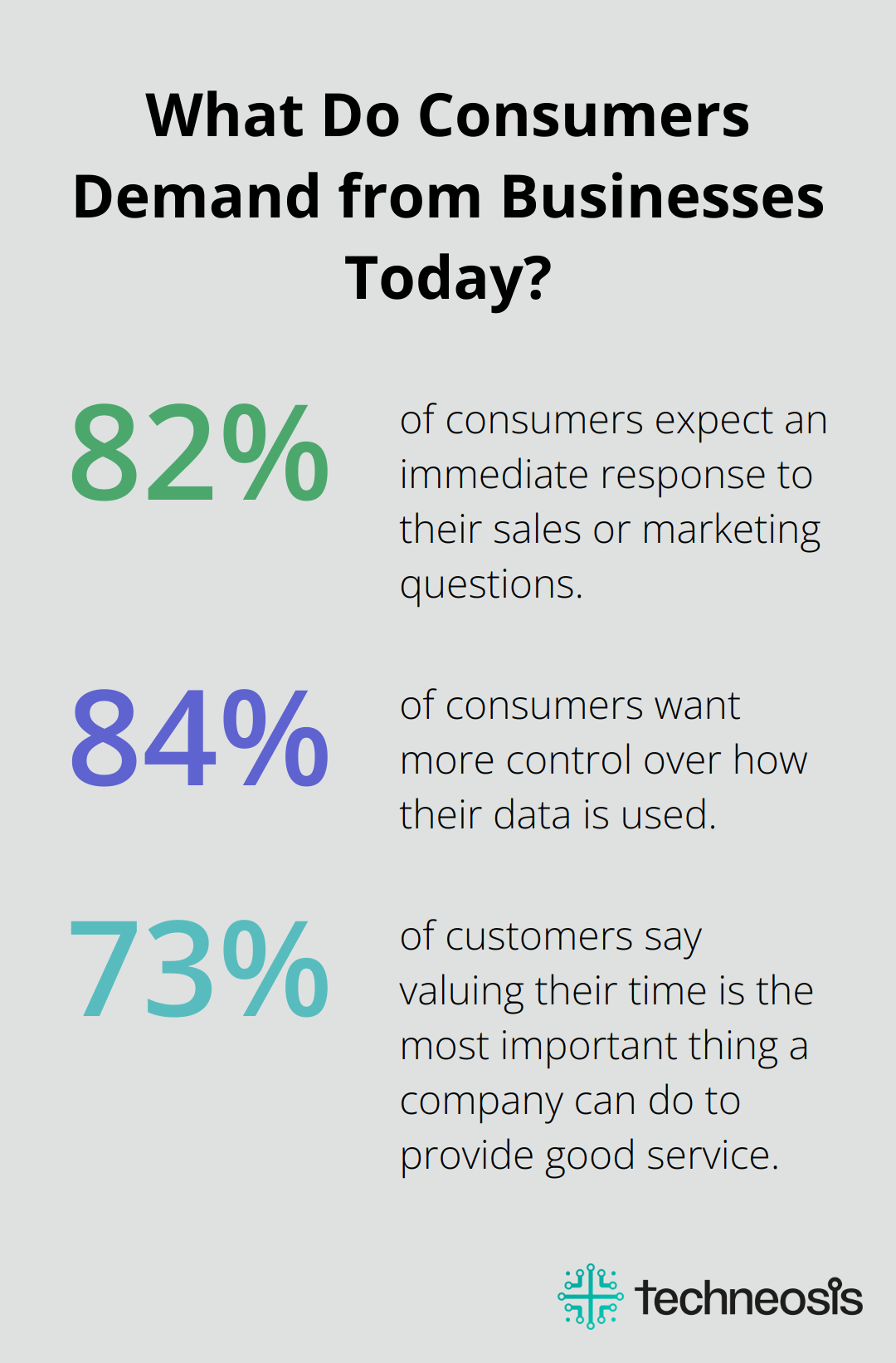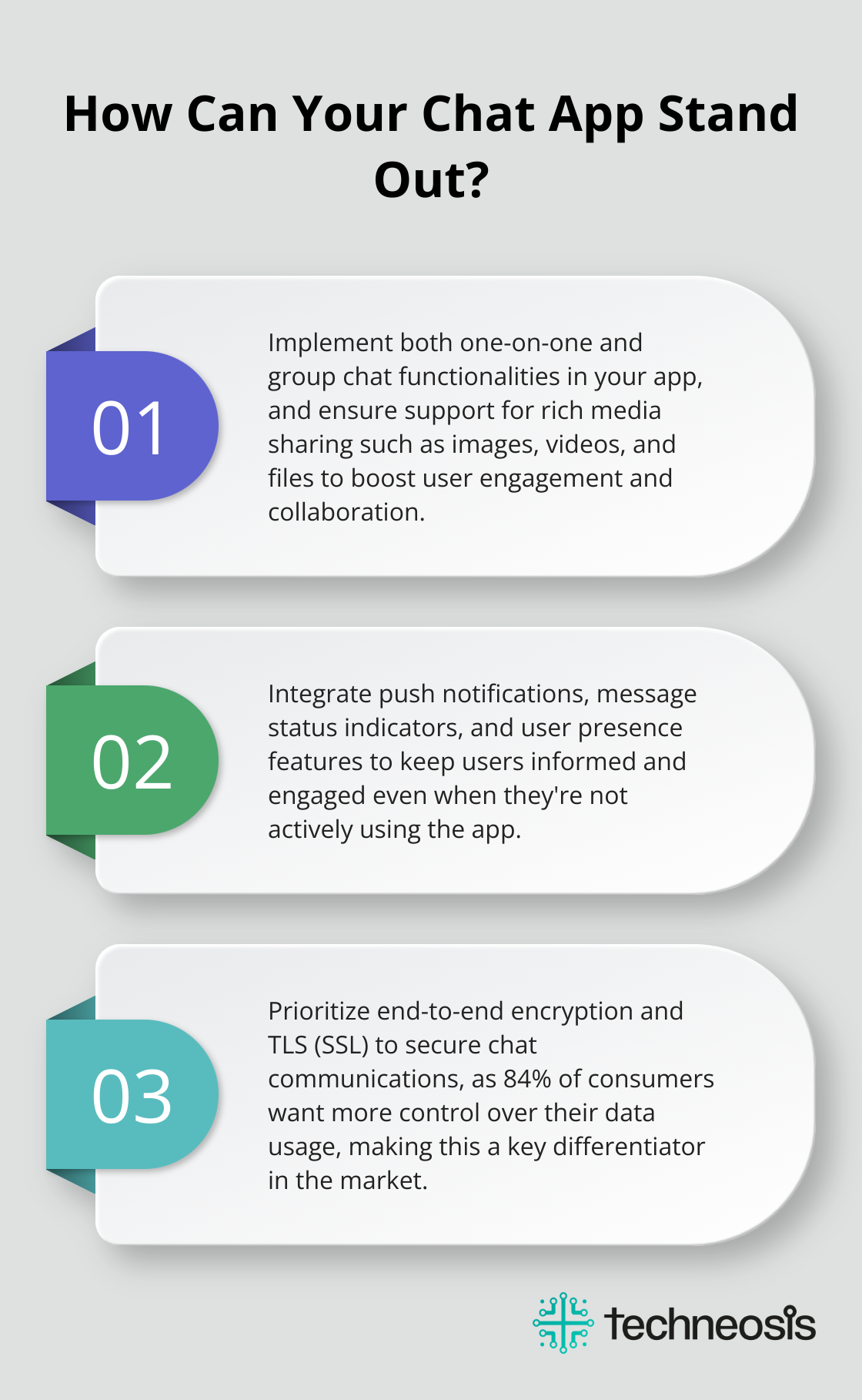Why Chat Transforms Mobile Apps
Revolutionizing User Engagement
Chat functionality in mobile apps acts as a powerful catalyst for user engagement. A study by Kayako reveals that live chat has had a positive effect on sales, revenue, and customer loyalty. This statistic underscores the impact of real-time interaction on user behavior. Chat features create a vibrant community within your app, encouraging users to visit more frequently and stay longer.
Supercharging Customer Support
The integration of chat into mobile apps elevates customer support to new heights. Econsultancy reports a striking difference in customer satisfaction rates: 73% for live chat support compared to 61% for email and 44% for phone support. This immediate assistance resolves issues faster, resulting in happier users and a reduced volume of support tickets.
Amplifying User Retention
Chat functionality proves to be a formidable tool for keeping users engaged with your app. According to Tidio, about 60% of customers say they are more likely to return to a website that offers live chat. In the mobile app ecosystem, this translates to improved retention rates and an increase in the lifetime value of users.

The impact on user retention is substantial. Stream, a leading chat API provider, reports that 45% of customers said their app’s user retention rate improved by at least two times after integrating the Stream Chat API. This statistic highlights the profound effect that real-time communication can have on user loyalty.
Fostering Real-Time Collaboration
Chat features in mobile apps open up new avenues for real-time collaboration among users. This functionality proves particularly valuable for team-based apps, project management tools, and social platforms. Users can exchange ideas, share updates, and make decisions instantly, all within the app environment. This real-time interaction not only enhances productivity but also creates a more dynamic and engaging user experience.
Personalizing User Experiences
Chat integration allows for a more personalized app experience. Through direct communication, businesses can gather valuable insights about user preferences, pain points, and behaviors. This information enables app developers to tailor features and content to individual users, creating a more relevant and engaging experience. Personalization (driven by chat interactions) can lead to increased user satisfaction and loyalty, further solidifying the app’s place in users’ daily routines.
As we move forward, it’s clear that chat functionality isn’t just an add-on feature-it’s a fundamental component that can redefine how users interact with mobile apps. The next section will explore the key features and considerations for successful chat integration, ensuring you make the most of this transformative technology.
What Makes Chat Integration Powerful?
The Foundation of Effective Chat
The cornerstone of successful chat integration lies in its support for both one-on-one and group conversations. This versatility allows users to engage in private discussions or collaborate in team settings, addressing a wide range of communication needs.

Text alone doesn’t suffice in today’s multimedia world. Rich media support is essential. Users expect to share images, videos, and files seamlessly within their chats. SMS marketing has shown conversion rates as high as 32% in certain campaigns, emphasizing its potential to significantly boost engagement.
Keeping Users Informed and Engaged
Push notifications and message status indicators play a vital role in maintaining user engagement, even when they’re not actively using the app. These features ensure that important messages don’t go unnoticed and provide users with real-time updates on the status of their communications.
User presence and typing indicators add another layer of real-time interaction. Knowledge of when someone is online or composing a message creates a sense of immediacy and connection. A report by Intercom indicates that 82% of consumers expect an immediate response to their sales or marketing questions, underscoring the importance of these real-time features.
Enhancing User Experience Through Functionality
Message history and search functionality (often overlooked but crucial for a smooth user experience) can save users significant time and frustration. The ability to scroll back through conversations or quickly find specific information proves invaluable. A study by Forrester Research found that 73% of customers say valuing their time is the most important thing a company can do to provide good service. Efficient message retrieval directly contributes to this time-saving aspect.
Prioritizing Security in Chat Integration
In an era where data breaches occur frequently, end-to-end encryption is not just a feature-it’s a necessity. Users need to trust that their conversations remain private and secure. TLS, also referred to as Secure Socket Layer or SSL, secures communication between the chat application and the backend server. A report by Cisco shows that 84% of consumers want more control over how their data is used. Implementation of robust encryption measures demonstrates a commitment to user privacy and can significantly differentiate an app in the market.
The implementation of these features requires careful planning and execution. Companies should focus on these key elements to create chat experiences that not only meet user expectations but exceed them, driving engagement and recognition in the process. As we move forward, we’ll explore the technical approaches to implementing these powerful chat features in your mobile app.
How to Implement Chat in Your Mobile App
Custom vs. Third-Party Solutions
The implementation of chat functionality in your mobile app requires a strategic approach. You have two main options: build a custom solution or use third-party SDKs and APIs.

Custom chat solutions offer complete control over every feature. However, they demand significant resources. A survey by Clutch indicates that custom software development projects can take 4 to 9 months to complete, with costs ranging from $50,000 to $250,000.
Third-party chat SDKs and APIs present a faster, more cost-effective alternative. These solutions allow you to leverage pre-built features and benefit from ongoing updates. (SendBird, a chat API provider, reports implementation times as short as 5 days.)
Open-Source Alternatives
Open-source chat frameworks like Matrix or XMPP offer a middle ground. These solutions provide flexibility and customization options without starting from scratch. However, they often require more development effort than commercial SDKs.
Scalability and Performance Considerations
Your chat system must handle increased load without compromising speed or reliability as your user base grows. This underscores the importance of optimizing your chat feature for speed and responsiveness.
Backend Infrastructure and Database Design
Your backend infrastructure plays a key role in chat performance. We recommend a distributed architecture with load balancing to ensure high availability and fault tolerance. For database design, consider a combination of relational databases for user data and NoSQL databases for chat messages to optimize for both structure and speed.
Handling Offline Scenarios
Offline support is essential in mobile environments. Implement local caching and message queuing to ensure a smooth user experience even when network connectivity is poor or unavailable. An offline-first app is able to perform all, or a critical subset of its core functionality without access to the internet.
Enhancing User Experience
When implementing chat functionality, it’s crucial to consider how it fits into your overall mobile app strategy. A well-designed chat feature can significantly boost user engagement and enhance your app’s value proposition. According to UX statistics, 74% of visitors are likely to return to a site with good mobile UX.
Final Thoughts
Mobile app chat integration transforms digital communication. It enhances user engagement, improves customer support, and increases retention rates. These advantages translate into higher customer satisfaction and increased revenue for businesses. The key to success lies in creating a seamless user experience with essential features like one-on-one and group chat capabilities, rich media support, and robust security measures.

We anticipate exciting developments in mobile app communication. The integration of AI and machine learning will lead to more personalized and efficient chat experiences. We also expect to see advancements in voice and video integration, further enhancing communication within mobile apps.
Businesses should act now to implement chat functionality and gain a competitive advantage. Techneosis specializes in guiding businesses through the process of implementing strategic technology solutions, including mobile app chat integration. Our expertise can help you navigate the complexities of chat implementation, ensuring your solution aligns with your business goals and user needs.




